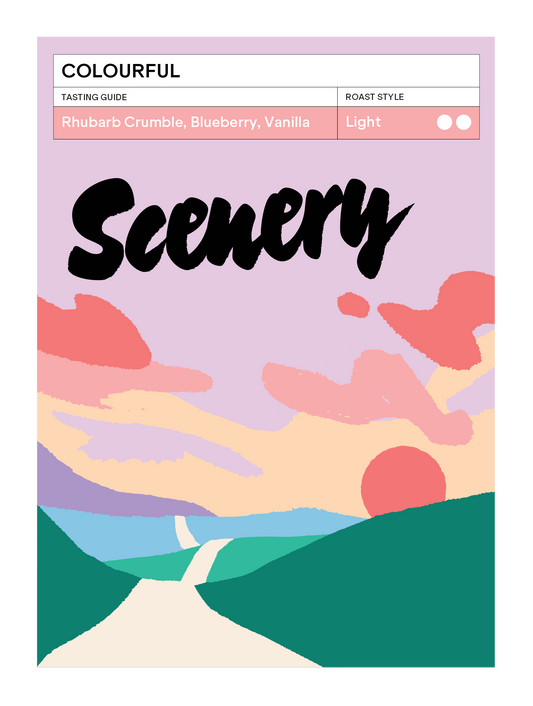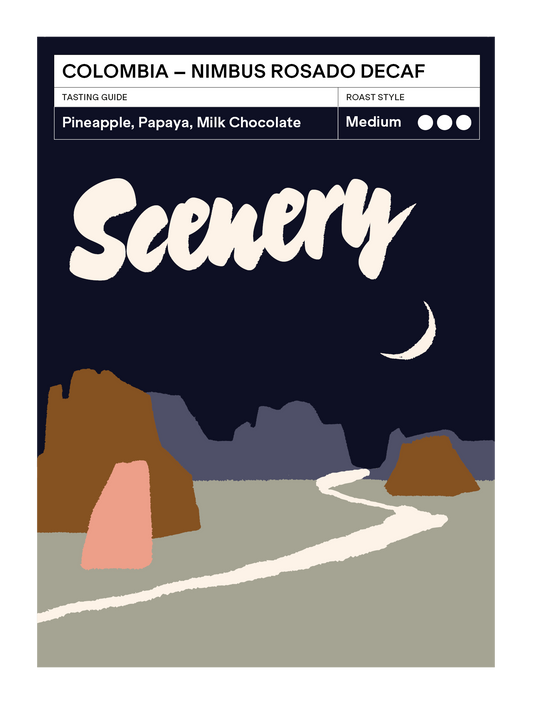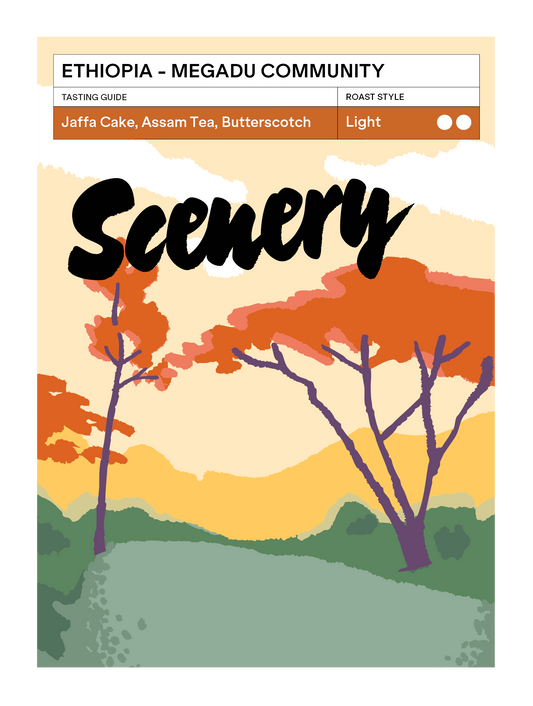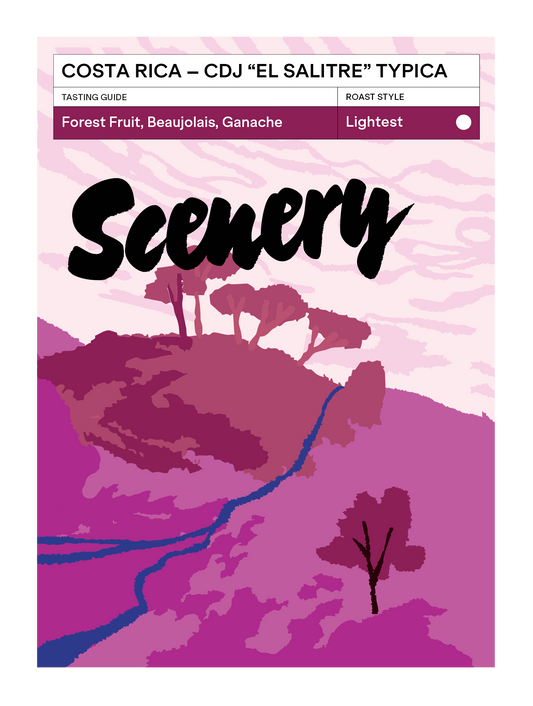We've had a few Indonesian anoxic naturals sourced via Sucafina's vertically integrated supply chains in the region, and they've all featured in Colourful. This year, we've decided to add a whole new continent - Asia - to our single origin lineup.
Second up is from the Wolo Wio smallholders in the island of Flores. Helped with processing via the Sucafina Indonesia team; this lot combines classic Indonesian cultivars with modern preperation - both cultivars in this lot have Arabica x Liberica crosses in their genetics which we reckon contributes to the interesting sweetness & profile.
Brew Guide:
Best Brewed with: Filter
Medium-Heavy Roaster Influence: We've had to push this one a lot harder to achieve what we wanted from it - finding it needs a hotter end temperature in the roaster and a longer overall roast period. Very syrupy textured and lots of heavy sugar browning notes.
Filter: 65g/L, 90°C Water, with rest we like to move down to 88°C.
Espresso: 18g, 38g, 25-30s
Best rested for: 3-4 weeks
We're tasting: Sweet chocolate & port wine aromatics, in the cup huge body. Morello cherry jam acidity, marizipan, fruit-forward dark chocolate, some dried papaya. As it cools there's a banana-esq tropicality in the finish
In Milk: Milk chocolate buttons, grilled banana, vanilla.
Traceability:
Country of Origin: |
Indonesia |
Region: |
Wolo Wio, Ngada, Flores |
Group Leaders: |
Tanta Reti & Om Bernardus |
Producers: |
Wolo Wio smallholders |
Variety: |
Ateng Ijo, Ateng Coklat (Catimor Lineage) |
Elevation: |
1300 - 1500 MASL |
Process: |
Anoxic Natural: Cherries picked, delivered to Sucafina's processing facility for floating and sorting, before fermentation in barrels with a one-way valve for 72 hours. After fermentation, the coffee is dried in racks in a parabolic drier. |
Import Partner: |
Sucafina |
Harvest: |
Crop 24/25, Arrived UK Feb 2025 |
The Story
Part of Indonesia's Lesser Sunda Islands, Flores is a long, narrow, and rugged island, stretching approximately 220 miles. Its name, meaning "Flowers" in Portuguese, was bestowed by 16th-century colonists, likely due to the vibrant “flamboyant” trees found on its eastern cape. However, local oral tradition in the Sikka region refers to the island as "Nusa Nipa," meaning "Dragon Island" or "Snake Island."
This “Laga Lizu” lot comes from the region of Bajawa in Flores, where smallholder coffee farmers typically manage plots averaging around 0.66 hectares on rugged volcanic terrain. This operational scale and geographical context often correlate with challenges in direct market access and logistical infrastructure. Property rights in Bajawa are traditionally handled by a matrilineal system where land ownership and farm management are often passed to women - a direct contrast to coffee production, which is distinctly patriarchal with the majority of farms owned by men (but oft worked on by women).
The farms are often run as polycultures (intercropping coffee with food crops and other cash crops like ginger, colocasia, and chayote; with the majority also farmed as (un-certified) organic. That last point isn’t necessarily by choice - agrochemical inputs, in remote logistically challenging areas tend to be expensive, and it’s much easier to develop composting methods to ensure a good nutrient cycle on the farm. It costs money as a producer to be certified as an organic farm, so whilst it may offer a value add to certain buyers, the cost is prohibitive for such small farms who depend massively on the income generated by each coffee harvest.
Indeed the process of Giling Basah (“wet hulled”) - almost entirely unique to Indonesia, where the protective coffee parchment layer is removed whilst the coffee is still wet, as opposed to when the coffee is dry and imminently about to be exported - comes from the need for producers to get paid promptly post-harvest and limited infrastructure to dry coffee. It’s extremely quick, allows coffee to be sold at the road-side (to the local equivalent of coyotes, who buy at a discount relative to the commercial rate, take it to larger facilities to be finished off, blended and sold). It’s quick - but it’s risky, being extremely prone to defects especially mould, and whilst some people love the profile (oft mixing purple fruits with tobacco, leather, & ceder wood)
There is a dual story at play in Indonesia - it’s got a thriving internal coffee market, and amongst the more affluent parts the speciality coffee scene is on a meteoric rise. Indeed, the latest “World of Coffee” global trade show has just been hosted in Jakarta, and much of Indonesia’s production is consumed internally.
Equally, smallholder market access is still limited - and it takes companies with on-the-ground presence, the ability to develop infrastructure, offer financing and quality programs to both increase the value of the coffee produced and get it in the hands of international buyers (like us! For example) so that we can bring it to our local markets.
We’ve been fans of the work that Sucafina have done in Indonesia over the last few years - working long term with co-operatives, the year-on-year return in investment has seen some crazy good coffees come out of it. This lot has been processed as an anoxic natural and it’s got some intense boozy macerated fruit and chocolate character, and we thought it banged as a milky drink so we’ve run it as the next espresso focused lot

![[65] Indonesia - Laga Lizu Espresso [CROP 24/25 ARCHIVE]](http://scenery.coffee/cdn/shop/articles/indonesia_laga_lizu_espresso_shopify.png?v=1750759968&width=1100)
![Colombia - Quebraditas Ají Thermal Shock Washed [FESTIVE SPECIAL] 🎄](http://scenery.coffee/cdn/shop/files/colombia_quebraditas_aji_shopify.png?v=1764358600&width=533)






![Colombia - Quebraditas Sidra Thermal Shock Washed [25/26]](http://scenery.coffee/cdn/shop/files/colombia_quebraditas_sidra_2526_shopify.png?v=1765544630&width=533)



![Colombia - Luz Ángela's Chiroso [25/26]](http://scenery.coffee/cdn/shop/files/colombia_luz_angela_chiroso_2526_shopify.png?v=1764359755&width=533)


![Colombia - El Jaragual Rosado [25/26]](http://scenery.coffee/cdn/shop/files/el_jaragual_rosado_2526.png?v=1757075842&width=533)